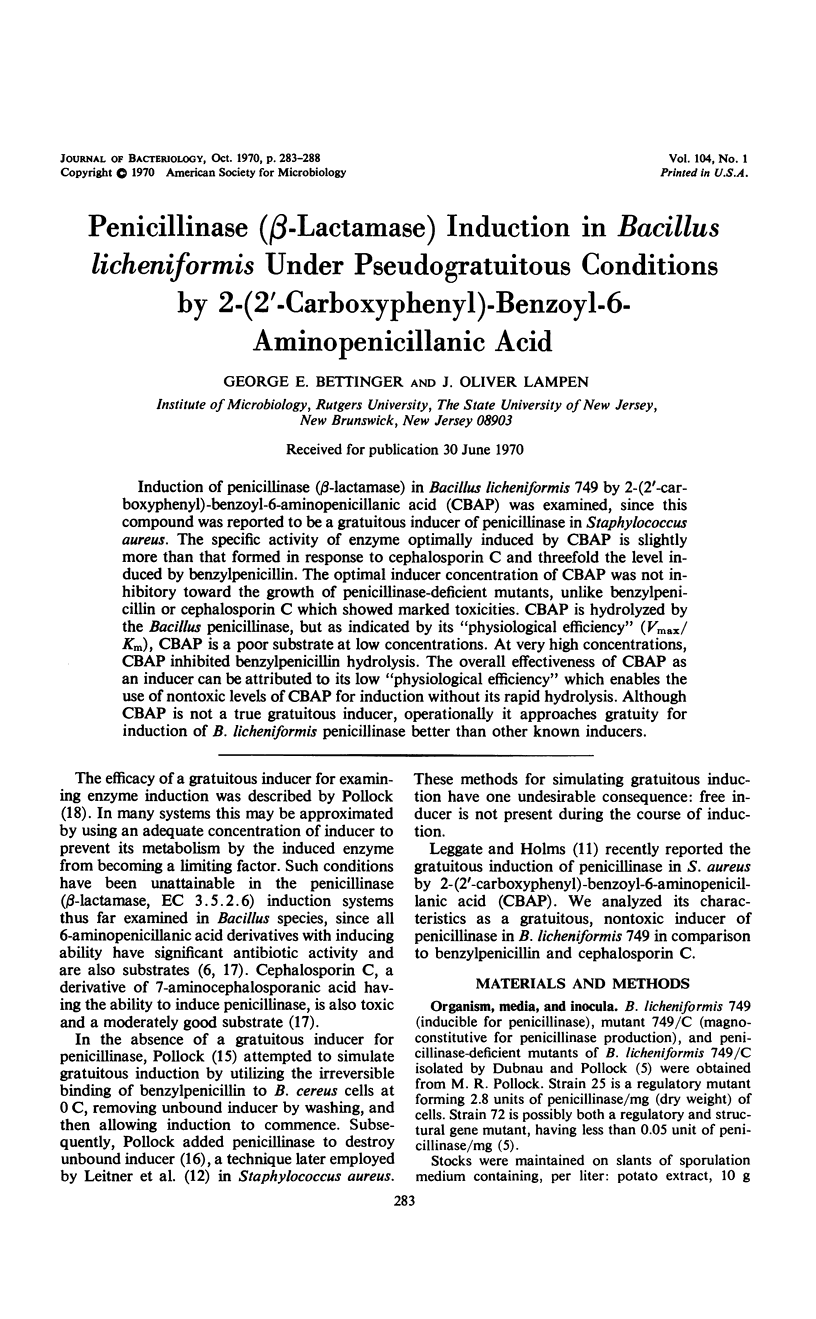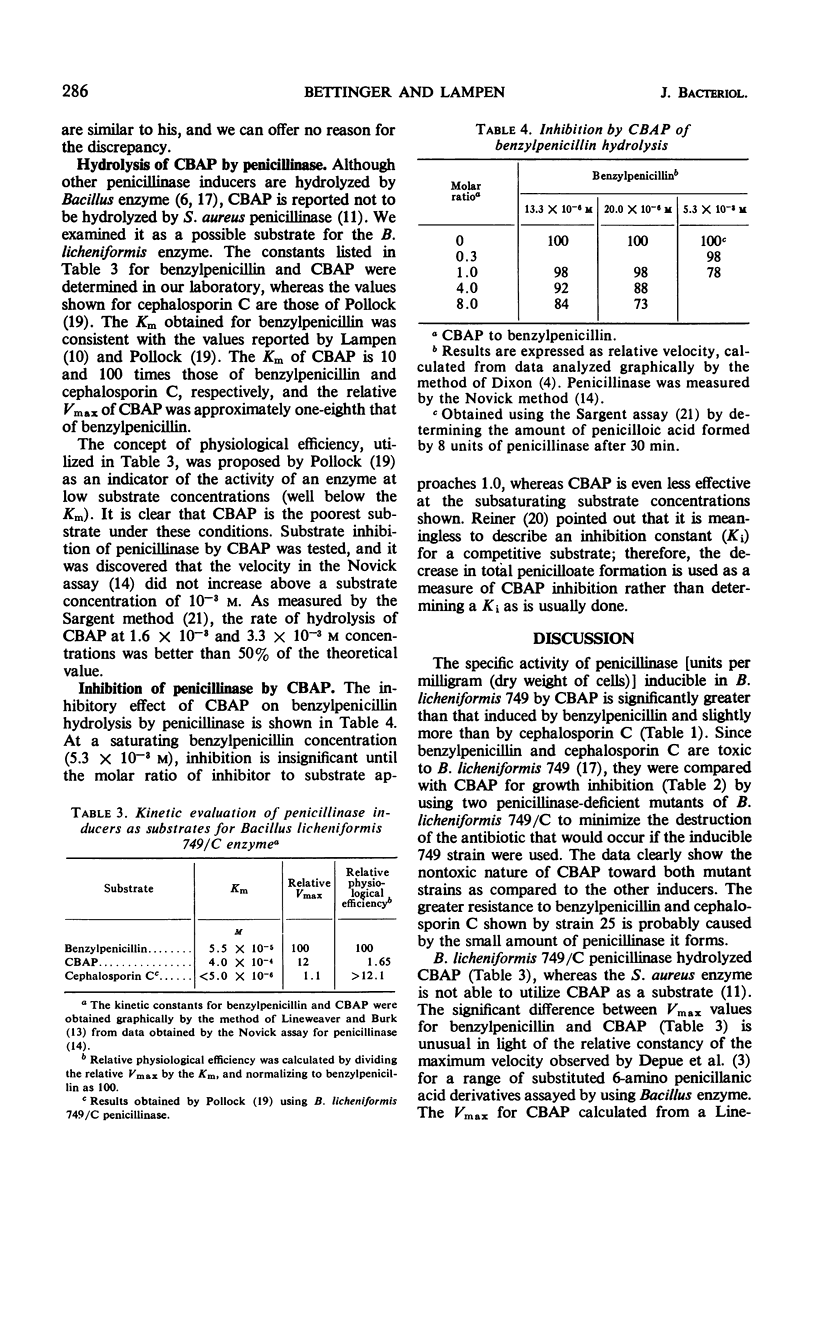Abstract
Induction of penicillinase (β-lactamase) in Bacillus licheniformis 749 by 2-(2′-carboxyphenyl)-benzoyl-6-aminopenicillanic acid (CBAP) was examined, since this compound was reported to be a gratuitous inducer of penicillinase in Staphylococcus aureus. The specific activity of enzyme optimally induced by CBAP is slightly more than that formed in response to cephalosporin C and threefold the level induced by benzylpenicillin. The optimal inducer concentration of CBAP was not inhibitory toward the growth of penicillinase-deficient mutants, unlike benzylpenicillin or cephalosporin C which showed marked toxicities. CBAP is hydrolyzed by the Bacillus penicillinase, but as indicated by its “physiological efficiency” (Vmax/Km), CBAP is a poor substrate at low concentrations. At very high concentrations, CBAP inhibited benzylpenicillin hydrolysis. The overall effectiveness of CBAP as an inducer can be attributed to its low “physiological efficiency” which enables the use of nontoxic levels of CBAP for induction without its rapid hydrolysis. Although CBAP is not a true gratuitous inducer, operationally it approaches gratuity for induction of B. licheniformis penicillinase better than other known inducers.
Full text
PDF





Selected References
These references are in PubMed. This may not be the complete list of references from this article.
- Csányi V., Jacobi G., Straub B. F. The regulation of penicillinase synthesis. Biochim Biophys Acta. 1967 Sep 26;145(2):470–484. doi: 10.1016/0005-2787(67)90065-2. [DOI] [PubMed] [Google Scholar]
- DEPUE R. H., MOAT A. G., BONDI A. THE RELATION BETWEEN PENICILLIN STRUCTURE AND PENICILLINASE ACTIVITY. Arch Biochem Biophys. 1964 Sep;107:374–381. doi: 10.1016/0003-9861(64)90293-0. [DOI] [PubMed] [Google Scholar]
- DIXON M. The determination of enzyme inhibitor constants. Biochem J. 1953 Aug;55(1):170–171. doi: 10.1042/bj0550170. [DOI] [PMC free article] [PubMed] [Google Scholar]
- Davies J. W. The stability and cell content of penicillinase messenger RNA in Bacillus licheniformis. J Gen Microbiol. 1969 Dec;59(2):171–184. doi: 10.1099/00221287-59-2-171. [DOI] [PubMed] [Google Scholar]
- Dubnau D. A., Pollock M. R. The genetics of Bacillus licheniformis penicillinase: a preliminary analysis from studies on mutation and inter-strain and intra-strain transformations. J Gen Microbiol. 1965 Oct;41(1):7–21. doi: 10.1099/00221287-41-1-7. [DOI] [PubMed] [Google Scholar]
- GARBER N., CITRI N. The interaction of penicillinase with penicillins. I. Effect of substrates and of a competitive inhibitor on native and urea-treated enzyme. Biochim Biophys Acta. 1962 Aug 13;62:385–396. doi: 10.1016/0006-3002(62)90268-8. [DOI] [PubMed] [Google Scholar]
- Ghosh B. K., Sargent M. G., Lampen J. O. Morphological phenomena associated with penicillinase induction and secretion in Bacillus licheniformis. J Bacteriol. 1968 Oct;96(4):1314–1328. doi: 10.1128/jb.96.4.1314-1328.1968. [DOI] [PMC free article] [PubMed] [Google Scholar]
- Imsande J. Regulation of penicillinase synthesis: evidence for a unified model. J Bacteriol. 1970 Jan;101(1):173–180. doi: 10.1128/jb.101.1.173-180.1970. [DOI] [PMC free article] [PubMed] [Google Scholar]
- LEITNER F., SWEENEY H. M., MARTIN T. F., COHEN S. INDUCTION OF STAPHYLOCOCCAL PENICILLINASE BY BENZYLPENICILLIN: EFFECT OF PH, CONCENTRATION OF FERROUS ION AND INDUCER, AND DURATION OF EXPOSURE OF CELLS TO INDUCER. J Bacteriol. 1963 Oct;86:717–727. doi: 10.1128/jb.86.4.717-727.1963. [DOI] [PMC free article] [PubMed] [Google Scholar]
- Lampen J. O. Cell-bound penicillinase of Bacillus licheniformis; properties and purification. J Gen Microbiol. 1967 Aug;48(2):249–259. doi: 10.1099/00221287-48-2-249. [DOI] [PubMed] [Google Scholar]
- Leggate J., Holms W. H. Gratuitous synthesis of beta-lactamase in Staphylococcus aureus. J Bacteriol. 1968 Dec;96(6):2110–2117. doi: 10.1128/jb.96.6.2110-2117.1968. [DOI] [PMC free article] [PubMed] [Google Scholar]
- NOVICK R. P. Micro-iodometric assay for penicillinase. Biochem J. 1962 May;83:236–240. doi: 10.1042/bj0830236. [DOI] [PMC free article] [PubMed] [Google Scholar]
- POLLOCK M. R. PURIFICATION AND PROPERTIES OF PENICILLINASES FROM TWO STRAINS OF BACILLUS LICHENIFORMIS: A CHEMICAL, PHYSICOCHEMICAL AND PHYSIOLOGICAL COMPARISON. Biochem J. 1965 Mar;94:666–675. doi: 10.1042/bj0940666. [DOI] [PMC free article] [PubMed] [Google Scholar]
- POLLOCK M. R. Penicillinase adaptation in B. cereus; adaptive enzyme formation in the absence of free substrate. Br J Exp Pathol. 1950 Dec;31(6):739–753. [PMC free article] [PubMed] [Google Scholar]
- POLLOCK M. R. Penicillinase adaptation in Bacillus cereus; an analysis of three phases in the response of logarithmically growing cultures to induction of penicillinase formation by penicillin. Br J Exp Pathol. 1952 Dec;33(6):587–600. [PMC free article] [PubMed] [Google Scholar]
- POLLOCK M. R. The activity and specificity of inducers of penicillinase production in Bacillus cereus, strain NRRL 569. Biochem J. 1957 Jul;66(3):419–428. doi: 10.1042/bj0660419. [DOI] [PMC free article] [PubMed] [Google Scholar]
- Sargent M. G., Ghosh B. K., Lampen J. O. Localization of cell-bound penicillinase in Bacillus licheniformis. J Bacteriol. 1968 Oct;96(4):1329–1338. doi: 10.1128/jb.96.4.1329-1338.1968. [DOI] [PMC free article] [PubMed] [Google Scholar]
- Sargent M. G. Rapid fixed-time assay for penicillinase. J Bacteriol. 1968 Apr;95(4):1493–1494. doi: 10.1128/jb.95.4.1493-1494.1968. [DOI] [PMC free article] [PubMed] [Google Scholar]


